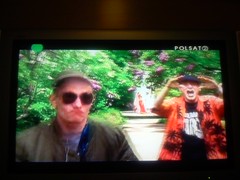
This has been widely noted elsewhere, but too resonant not to repeat here: the Guardian on Will Self's workspace:
"I'm going to end up like one of those old weirdos who lives in a network of tunnels burrowed through trash - yet I do not fear this."


Here's something I did on my summer vacation—not that working three science fiction conventions in four weeks, in parts of the country experiencing a triple-digit heat wave, constitutes a vacation in the normal sense of the word. Anyway, in late July I drove from
They turn out to be Muscogee (Creek) Indian names, echoes of people who lived
The forced removal was called the Trail of Tears. It was a wretched historical episode. American ethnic cleansing. To make it, if possible, even worse, Indian spirituality is generally connected to land in a way that Western spirituality isn't. Exile from ancestral land meant being cut off at the religious, cultural and even medicinal roots. This was explained to me once by a Lutheran theologian who belongs to the Osage Nation. He said that after being forced from Missouri to Oklahoma, Osage medicine people practiced less of their traditional medicine, and part of the reason was unfamiliar plant life. They didn't know the healing properties of plants in Oklahoma.
I recall precious little awareness of Indian peoples in
There were a lot of migrations and upheavals of Indian peoples in the centuries after 1492. Topping it all off with removal and genocide, the end game was a colossal land grab by Europeans in North America. Now we live on stolen land, as the Lutheran Osage theologian emphatically pointed out to me. He added that the morality of living on stolen land can get sticky even for Indian people. He was then living in
For a lot of mostly irreparable reasons, most Americans dwell on the land of ancestors other than our own. Sometimes the original people are gone. The
Conestoga in an SFFnal sense, namely Oklahoma's largest literary science fiction and fantasy convention, is a good con with a flair for originality. This year the con's charity was Safari's Sanctuary. The Safari's Sanctuary people rescue wild and exotic animals from the pet trade and from overpopulated zoos. They do educational outreach too, bringing some of the animals: wolves and lemurs and oh my—Carmella, the Burmese Python. A Safari's Sanctuary volunteer draped her on interested shoulders at Conestoga. A big (well fed, mellow) snake is all languid muscle from tip to tail. When you're wearing one, you feel the muscles flex as the snake shifts position. Not a suitable pet, but an amazing creature.
Carmella may be a kindred soul of mine.








Witnesses say it looks like a cross between a dinosaur and a vampire. Others say it’s a hopping wolf with red eyes and a trail of foul smell, while some claim it resembles a small panther with a forked tongue.
Whatever the description, variations of the legend of the chupacabra can be found in Puerto Rico, Mexico, Nicaragua, Chile and Florida, among others. Originating in Puerto Rico, the name of the chupacabra, translated in Spanish as “goat sucker,” began with the macabre discovery of large numbers of dead goats.
The goats were found with puncture wounds in their necks and blood allegedly drained from their bodies. Confused farmers in rural Puerto Rican villages claimed that they saw strange animals attacking their livestock. These claims multiplied and eventually led to a widespread belief in the mythical beast.
Through the years, the mystery animal has supposedly been sighted, captured and killed in a handful of locales across the Americas. The most recent finding to make headlines is in Dewitt County, near the small town of Cuero, southeast of San Antonio.
Phylis Canion found the corpse of a strange-looking critter on her property in late July. Claiming that the animal killed numerous cats in the area and sucked the blood from her chickens for a number of years, Canion collected the blue-colored road kill off Highway 183. Upon closer inspection, she couldn’t place a name to it.
Determined to find out the identity of her discovery, she contacted KENS-5, a CBS broadcast affiliate in San Antonio. The news station was also curious, and sent a tissue sample to Texas State University-San Marcos for DNA testing.
The Department of Biology received the remains late this summer and is currently running tests to divulge the classification of the animal in the lab’s Beckman-Coulter CEQ 8800 DNA sequencer.
“This is part of a Mexican, Caribbean and Latin-American cultural phenomenon,” said Michael Forstner, professor of biology at Texas State and facilitator of the DNA tests. “While we don’t have the skull, from the images we have we can tell you that it’s a canid, it’s in the dog family Canidae.”
The reason the department doesn’t possess the skull is because the head of the animal was removed by Canion. She placed it in her freezer to preserve it for a decorative mount on her wall, leaving DNA testing as the remaining means in which to conclusively identify the beast.
“We’ll extract the DNA and amplify it using DNA markers suitable for mammals and carnivores,” Forstner said. “When we’re done, we’ll run the results against our online database and see what it matches.”
Supposed chupacabras that have undergone testing in the past often turn out to be wild dogs, foxes or coyotes. In this case, Forstner says the department should easily be able to find a match.
“If you’re asking me if this is a new life form, then I’d have to say no,” Forstner said.
The discovery has turned into national news, finding air on radio talk shows from Los Angeles to New York and being reported on television news stations across the country. The story even found its way into Jimmy Kimmel’s monologue, with the late-night talk show host joking that Canion had kept the remains to make “chalupacabras.”
Students around campus remain wary that such an animal exists.
“I was raised on the idea of the chupacabra--it’s silly folklore, like the boogeyman,” said Thomas Daniel, a criminal justice graduate from San Antonio. “My mom used to tell me that if I didn’t go to sleep, the chupacabra would take me away.”
Others say there’s a possibility that the creature may be grounded in reality, not just in the minds of misbehaved children.
“I don’t know if (the animal in the photo) is technically the chupacabra I’ve heard about in stories, but it’s something not ordinary,” said Luis Garza, international business senior from Brazoria. Garza studied the photograph of the animal closely before making his conclusion. “It could be a cross-breed… or genetic mutation.”
While scientists and students are skeptical of the legend, only the tests will tell for sure. The identity of the animal will be uncovered in a few weeks when DNA testing is complete.





My friend and I had a picnic the other day in
1. A water skier practicing his moves who worked his way up to doing complete somersaults. Nice show, but the boat motor was loud, so we took a walk.
2. A snowy egret in flight, a delicately plumed white bird with ridiculously yellow feet. The yellow feet are practical: the bird can tell the difference between its own toes and the wiggly prey it hunts in shallow water.
3. Fish fingerlings, lots of them, in two very small ponds – more like large puddles – connected by a drain pipe under a roadway. We've had plenty of rain this summer, evidently enough rain to generate puddles durable enough for that many fingerlings to hatch and put on an inch or two of growth. The presence of all those fishies may say something about the abundance of mosquito larvae for them to eat. It may also say something about the culinary prospects for the local egrets and herons.
4. Extremely large spiders of a species always abundant in Challenger Park this time of year. They are the Golden Silk Orbweavers (Nephila clavipes) also variously called Banana Spiders and Giant Woods Spiders. They can be a couple of inches long exclusive of leg, and they construct webs wide enough to span a small road. My friend and I took a close-up look at one specimen. Its cephalothorax (i.e., the front section of a spider) resembled the Jason-horror-films hockey mask, in good time for Halloween. And it had furry knees.
5. Hot pink dragonflies: Roseate Skimmers. When the insects are older (middle-aged in dragonfly years?) the color cools to a lavender pink, but the young males are hot pink. In sunlight they looked like shards of neon signage.
~~~~
So today my spiritual director comments, "Nature is the original temple. A nondenominational one." Complete with hot pink dragonflies and furry-kneed spiders and a lot of other unexpected things, including hurricanes.
I think I saw the tropical storm that became Hurricane Humberto this week – watched it pass our area by. Late that day I went for a walk, with a rain hat and plans to bolt for home in the event of threatening lightning. The sun gilded clouds in the west, while dark cloud fragments scudded across the sky overhead. To the southeast a sturdy-looking rainbow framed stacks of gray cloud. About halfway through my 3-mile walk, a rather strong wind picked up out the east, and blew steadily. At that point my crocodile brain ran its own little storm warning flag up the pole. But I kept going – no lightning yet – and the wind soon slackened. The clouds in the southeast seemed to melt away. My crocodile brain called off the storm warning. So did the weather forecasters. It was as if I'd seen the skirts of the storm swirling by in the distance as Humberto took an unpredicted turn to the east, away from
"Nature is the original temple." That works for me if it's understood that what's found in a house of worship is not predictable and safe. By most accounts, safe and predictable are not attributes of the divine mystery anyway. Having a picnic in a park is enough like communion or ritual feast to adorn the metaphor. Birds and fish and insects are less the metaphorical equivalent of interior decoration than they are fellow congregants. The water-skier? A sideshow; and most times you go into a church there's a human sideshow in progress. Attending temple/church with a human friend and fellow creatures, including spiders with furry knees... may not be a bad way to think about a picnic in the park.




A new brand of creationism, which creationists and secular science
are not familiar with is "Biblical Reality", which is better known as
the "Observations of Moses".
This "Old Earth" brand of creationism puts forth the view that
combines a seven 24-hr day week of original creation (Exodus 20:11),
with a separate "six 12-hr days of revelation" given to Moses
(Genesis 1:2 – 2:3). The pseudo discrepancy between the "sixth day"
in Genesis chapter one and in chapter two is explained as chapter two
being the beginning of modern mankind (Adam & Eve), and chapter
one as being an earlier species of prehistoric mankind in an earlier
restoration period, more than 60 million years ago.
Biblical Reality is defined as the "ordained marriage" of Biblical
Truth, and Scientific Reality. Think of Biblical Truth as historical,
present, or future data (information) that has been given to us by
the words written in the Bible, or what we shall call "The Printed
Word of God". It is events which took place in the past, that we may
not presently be able to confirm outside of the Bible.
Scientific Reality is defined as "That which has been discovered and
analyzed to be of true historical existence. That which has been
observed to be a real occurrence or phenomena, whether or not it
can be explained." For example, the discoveries of the extinctions
of life on Earth in what has been determined to be 245 Million BC
(dimetrodons) and 65 Million BC (dinosaurs) is accepted as Scientific
Reality.
Biblical Reality teaches that there are no "creation accounts" in
Genesis, and that "Moses Didn't Write About Creation!". What
is actually being said is "Moses wrote about multiple restorations".
Before the advent of "Biblical Reality", no faction of creationism
could explain both the "first day" of Moses and the "Fourth Day",
all being 24-hr days, without either denying literal interpretation or
"redefining" the scriptures.
The "six days of Moses" in Genesis chapter one are actually six
consecutive (12 hour) days in 1598 BC that God revealed to Moses
(on Mt. Sinai) from the ancient past. Each day was from the first
week of each of seven different geological eras in "biblical order".
The only day of Creation Week which Moses saw was the
"Fourth Day". Creation Week was 168 hours, in 4.6 Billion BC,
according to the geologist.
